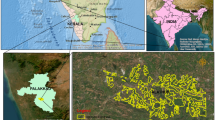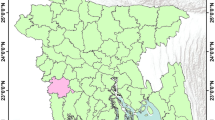Abstract
In the present study, the differences in the kharif crop reflectance at varied wavelength regions and temporal SAR backscatter (at VV and VH polarizations) during different crop stages were analyzed to classify crop types in parts of Ranchi district, East India using random forest classifier. The spectral signature of crops was generated during various growth stages using temporal Sentinel-2 MSI (optical) satellite images. The temporal backscatter profile that depends on the geometric and di-electric properties of crops were studied using Sentinel-1 SAR data. The spectral profile exhibited distinctive reflectance at the NIR (0.842 µm) and SWIR (1.610 µm) wavelength regions for paddy (Oryza sativa; ~0.25 at NIR, ~0.27 at SWIR), maize (Zea mays; ~0.24 at NIR, ~0.29 at SWIR) and finger millet (Eleusine coracana, ~0.26 NIR, ~0.31 at SWIR) during pre-sowing season (mid-June). Similar variations in crop’s reflectance at their different growth stages (vegetative to harvesting) were observed at various wavelength ranges. Further, the variations in the backscatter coefficient of different crops were observed at various growth stages depending upon the differences in sowing–harvesting periods, field conditions, geometry, and water presence in the crop field, etc. The Sentinel-1 SAR based study indicated difference in the backscatter of crops (i.e., ~−18.5 dB (VH) and ~−10 dB (VV) for paddy, ~−14 dB (VH) and ~−7.5 dB (VV) for maize, ~−14.5 dB and ~−8 dB (VV) for finger millet) during late-July (transplantation for paddy; early vegetative for maize and finger millet). These variations in the reflectance and backscatter values during various stages were used to deduce the best combination of the optical and SAR layers in order to classify each crop precisely. The GLCM texture analysis was performed on SAR for better classification of crop fields with higher accuracies. The SAR-MSI based kharif crop assessment (2017) indicated that the total cropped area under paddy, maize and finger millet was 24,544.55, 1468.28 and 632.48 ha, respectively. The result was validated with ground observations, which indicated an overall accuracy of 83.87% and kappa coefficient of 0.78. The high temporal, spatial spectral agility of Sentinel satellite are highly suitable for kharif crop monitoring. The study signifies the role of combined SAR–MSI technology for accurate mapping and monitoring of kharif crops.






Similar content being viewed by others
References
Aschbacher J, Pongsrihadulchai A and Karnchanasutham S 1995 Assessment of ERS-1 SAR data for rice crop mapping and monitoring; Int. Geosci. Remote Sens. Symp. IGARSS ’95, Quant. Remote Sens. Sci. Appl. 3 2183–2185.
Bouman B A M and Hoekman D H 1993 Multi-temporal multi-frequency radar measurements of agricultural crops during the Agriscatt-88 campaign in The Netherlands; Int. J. Remote Sens. 14(8) 1595–1614.
Berberoglu S and Curran P J 2004 Merging spectral and textural information for classifying remotely sensed images. In: Remote Sensing Image Analysis: Including The Spatial Domain (eds) Jong S M D and Meer F D V Remote Sens. Digital Image Process. 5 113–136.
Brisco B and McNairn H 2004 The application of C-band polarimetric SAR for agriculture: A review; Can. J. Remote Sens. 30 525–542.
Bargiel D and Herrmann S 2011 Multi-temporal land-cover classification of agricultural areas in two European regions with high resolution spotlight TerraSAR-X data; Remote Sens. 3 859–877.
Braun A and Hochschild V 2015 Combining SAR and optical data for environmental assessments around refugee Camps; J. Geogr. Infor. Sci. 1 424–433.
Chakraborty M, Panigrahy S and Sharma S A 1997 Discrimination of rice crop grown under different cultural practices using temporal ERS-1 synthetic aperture radar data; ISPRS J. Photogramm. Remote Sens. 52 183–191.
Choudhury I and Chakraborty M 2006 SAR signature investigation of rice crop using RADARSAT data; Int. J. Remote Sens. 27 519–534.
Census of India 2011 District Census Hand Book, Ranchi, Jharkhand, Government of India, Series-21, Part XII-A.
Cong N, Wang T, Nan H, Ma Y, Wang X, Myneni R B and Piao S 2013 Changes in satellite-derived spring vegetation green-up date and its linkage to climate in China from 1982 to 2010: A multimethod analysis; Glob. Change Biol. 19 881–891.
Du P, Samat A, Waske B, Liu S C and Li Z H 2015 random forest and rotation forest for fully polarized SAR image classification using polarimetric and spatial features; ISPRS J. Photogramm. Remote Sens. 105 38–53.
Franklin S E, Hall R J, Moskal L M, Maudie A J and Lavigne M B 2000 Incorporating texture into classification of forest species composition from airborne multispectral images; Int. J. Remote Sens. 21 61–79.
Freeman A and Durden S L 1992 A three component scattering model to describe polarimetric SAR data. In: Proceedings of the SPIE Conference on Radar Polarimetry, CA, San Diego 1748, pp. 213–225.
Freeman A 2007 Fitting a two-component scattering model to polarimetric SAR data from forests; IEEE Trans. Geosci. Remote Sens. 45(8) 2583–2592.
Forkuor G, Conrad C, Thiel M, Ullmann T and Zoungrana E 2014 Integration of optical and synthetic aperture radar imagery for improving crop mapping in northwestern Benin, West Africa; Remote Sens. 6 6472–6499.
Ghimire B, Rogan J and Miller J 2010 Contextual land-cover classification: Incorporating spatial dependence in land-cover classification models using random forests and the Getis statistic; Remote Sens. Lett. 1 45–54.
Inoue Y, Kurosu T, Maeno H, Uratsuka S, Kozu T and Zielinska K D 2002 Season-long daily measurements of multifrequency (Ka, Ku, X, C, and L) and full-polarization backscatter signatures over paddy rice field and their relationship with biological variables; Remote Sens. Environ. 81 194–204.
Inglada J, Vincent A, Arias M and Marais-Sicre C 2016 Improved early crop type identification by joint use of high temporal resolution sar and optical image time series. Remote Sens. 8(5) 362.
Johansen K, Coops N C, Gergel S E and Stange Y 2007 Application of high spatial resolution satellite imagery for riparian and forest ecosystem classification; Remote Sens. Environ. 110 29–44.
Jia K, Li Q, Tian Y, Wu B, Zhang F and Meng J 2012 Crop classification using multi-configuration SAR data in the North China Plain; Int. J. Remote Sens. 33 170–183.
Kurosu T, Fujita M and Chiba K 1995 Monitoring of rice crop growth from space using the ERS-1 C-band SAR; IEEE Trans. Geosci. Remote Sens. 33 1092–1096.
Lopez-Sanchez J M, Cloude S R and Ballester-Berman J D 2012 Rice phenology monitoring by means of SAR polarimetry at X-band; IEEE Trans. Geosci. Remote Sens. 50 2695–2709.
Lobell D B 2013 The use of satellite data for crop yield gap analysis. Field Crops Res. 143 56–64.
Oyoshi K, Tomiyama N, Okumura T, Sobue S and Sato J 2016 Mapping rice-planted areas using time-series synthetic aperture radar data for the Asia-RiCE activity; Paddy Water Environ. 14 463–472.
Panigrahy S, Manjunath K R and Chakraborty M 1999 Evaluation of RADARSAT standard beam data for identification of potato and rice crops in India; ISPRS J. Photogramm. Remote Sens. 54 254–262.
Pearlstine L, Portier K M and Smith S E 2005 Textural discrimination of an invasive plant, Schinusterebinthifolius, from low altitude aerial digital imagery; Photogramm. Eng. Remote Sens. 71 289–298.
Skriver H, Svendsen M T and Thomsen A G 1999 Multitemporal C- and L-band polarimetric signatures of crops; IEEE Trans. Geosci. Remote Sens. 37 2413–2429.
Shao Y, Fan X, Liu H, Xiao J, Ross S, Brisco B, Brown R and Staples G 2001 Rice monitoring and production estimation using multitemporal RADARSAT; Remote Sens. Environ. 76(3) 310–325.
Soria-Ruiz J, Fernandez-Ordonez Y and McNairm H 2009 Corn monitoring and crop yield using optical and microwave remote sensing; Geosci. Remote Sens. 10 405–419, https://doi.org/10.5772/8311.
Toan T Le, Ribbes F, Wang L F, Nicolas F, Ding K H, Kong J A, Fujita M and Kurosu T 1997 Rice crop mapping and monitoring using ERS-1 data based on experiment and modeling results; IEEE Trans. Geosci. Remote Sens. 35 41–56.
Turkar V, Deo R, Rao Y S, Mohan S and Das A 2012 Classification accuracy of multi-frequency and multi-polarization SAR images for various land covers; IEEE J. Sel. Top. Appl. Earth Obs. Remote Sens. 5(3) 936–941.
Torbick N, Chowdhury D, Salas W and Qi J 2017 Monitoring rice agriculture across Myanmar using time series Sentinel-1 assisted by Landsat-8 and PALSAR-2; Remote Sens. 9(2) 119.
Ulaby F T, Robert Y L and Shanmugan K S 1982 Crop classification using airborne radar and Landsat data; IEEE Trans. Geosci. Remote Sens. 1 42–51.
Zhou T, Pan J and Zhang P 2017 Mapping winter wheat with multi-temporal SAR and optical images in an urban agricultural region; Sensors (Switzerland) 17 1–16.
Acknowledgements
The authors would like to thank editors and reviewers for their valuable comments and suggestions. Authors also convey their gratitude to the European Space Agency (ESA) for free accessibility to Sentinel-1 and Sentinel-2 satellite data. They also would like to thank District Agriculture office (DAO), Ranchi for providing with crop statistical data for kharif 2017.
Author information
Authors and Affiliations
Corresponding author
Additional information
Communicated by Prashant K Srivastava
Rights and permissions
About this article
Cite this article
Verma, A., Kumar, A. & Lal, K. Kharif crop characterization using combination of SAR and MSI Optical Sentinel Satellite datasets. J Earth Syst Sci 128, 230 (2019). https://doi.org/10.1007/s12040-019-1260-0
Received:
Revised:
Accepted:
Published:
DOI: https://doi.org/10.1007/s12040-019-1260-0




